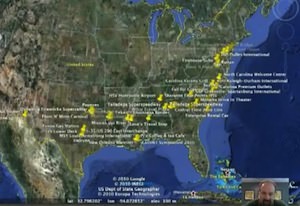Raytheon Creates Social Media Spy Software (Video)
The world's fifth-largest defense contractor has developed a surveillance program that predicts your behavior by tracking the movement of your smartphone and mining public data from sites such as Twitter, Facebook and Foursquare.
The world’s fifth-largest defense contractor has developed a surveillance program that predicts your behavior by tracking the movement of your smartphone and mining public data from sites such as Twitter, Facebook and Foursquare.
Virtually unlimited amounts of personal data flow unprotected through cyberspace. That means the only remaining obstacle to a full-blown digital surveillance state has been the problem of how to quickly organize and analyze it. The Riot program (Rapid Information Overlay Technology) seems to remove that obstacle by enabling its controller to “gain an entire snapshot of a person’s life — their friends, the places they visit … in little more than a few clicks of a button.”
In a video obtained by The Guardian (visible below), Raytheon’s “principal investigator” Brian Urch explains how locational data can be obtained from photographs posted on social networking sites via smartphones.
“Riot can display on a spider diagram the associations and relationships between individuals online by looking at who they have communicated with over Twitter,” Ryan Gallagher writes at The Guardian. “It can also mine data from Facebook and sift GPS location information from Foursquare, a mobile phone app used by more than 25 million people to alert friends of their whereabouts. The Foursquare data can be used to display, in graph form, the top 10 places visited by tracked individuals and the times at which they visited them.”
Although Raytheon says it has not sold its software to any clients, mining from public websites by law enforcement is considered legal in most countries. In February 2012, the FBI sought help developing “a social media mining application for monitoring ‘bad actors or groups.’ “
— Posted by Alexander Reed Kelly.
Ryan Gallagher at The Guardian:
“We’re going to track one of our own employees,” Urch says in the video, before bringing up pictures of “Nick,” a Raytheon staff member used as an example target. With information gathered from social networks, Riot quickly reveals Nick frequently visits Washington Nationals Park, where on one occasion he snapped a photograph of himself posing with a blonde haired woman.
“We know where Nick’s going, we know what Nick looks like,” Urch explains, “now we want to try to predict where he may be in the future.”
… The video shows that Nick, who posts his location regularly on Foursquare, visits a gym frequently at 6am early each week. Urch quips: “So if you ever did want to try to get hold of Nick, or maybe get hold of his laptop, you might want to visit the gym at 6am on a Monday.”
The Guardian:
Your support is crucial…With an uncertain future and a new administration casting doubt on press freedoms, the danger is clear: The truth is at risk.
Now is the time to give. Your tax-deductible support allows us to dig deeper, delivering fearless investigative reporting and analysis that exposes what’s really happening — without compromise.
Stand with our courageous journalists. Donate today to protect a free press, uphold democracy and unearth untold stories.





